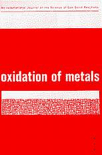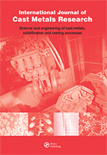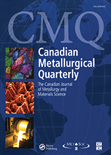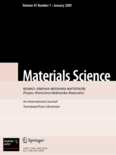
OXIDATION OF METALS
Scope & Guideline
Charting New Paths in Oxidation and Alloy Studies
Introduction
Aims and Scopes
- High-Temperature Oxidation Mechanisms:
The journal extensively covers the fundamental mechanisms of oxidation at elevated temperatures, exploring how different materials behave under oxidative conditions and the factors that influence their oxidation resistance. - Corrosion Behavior of Alloys:
Research on the corrosion resistance of various metal alloys, especially under extreme conditions such as high temperatures and aggressive atmospheres, is a core focus. This includes studies on both ferrous and non-ferrous alloys. - Innovative Coating Techniques:
The journal also emphasizes the development and performance evaluation of protective coatings designed to enhance oxidation resistance, including thermal barrier coatings and novel alloy compositions. - Application of Advanced Characterization Techniques:
Papers often utilize advanced microscopy and spectroscopy techniques to characterize oxidation processes and material degradation, providing insights into microstructural changes during oxidation. - Modeling and Simulation of Oxidation Processes:
The use of computational models and machine learning approaches to predict oxidation behavior and corrosion kinetics is another key area of interest, reflecting a trend towards data-driven research in materials science.
Trending and Emerging
- Application of Machine Learning in Predicting Oxidation Behavior:
The integration of machine learning techniques to predict oxidation kinetics and corrosion behavior is rapidly increasing, showcasing the journal's commitment to modern methodologies that enhance predictive capabilities. - High-Entropy Alloys and Their Oxidation Resistance:
Research on high-entropy alloys and their unique oxidation properties is on the rise, highlighting the interest in developing new materials that can withstand severe oxidative environments. - Impact of Environmental Factors on Oxidation:
Studies examining the influence of various environmental factors such as humidity, temperature, and gas composition on oxidation processes are becoming more prominent, reflecting a holistic approach to understanding material performance. - In Situ and Real-Time Monitoring Techniques:
There is a growing trend towards in situ monitoring of oxidation processes using advanced techniques, allowing researchers to observe real-time changes and behaviors of materials during oxidation. - Sustainable and Alternative Materials Research:
The journal is increasingly featuring research focused on sustainable materials and alternatives to traditional alloys, addressing the need for environmentally friendly solutions in high-temperature applications.
Declining or Waning
- Low-Temperature Oxidation Studies:
Research focusing on oxidation mechanisms at lower temperatures has become less prevalent, possibly due to the increasing emphasis on high-temperature applications in industries such as aerospace and power generation. - Basic Alloy Composition Studies:
There appears to be a waning interest in studies that solely focus on basic composition effects without integrating advanced techniques or applications. This shift may be due to the growing demand for practical applications and performance evaluations. - Traditional Corrosion Testing Methods:
There is a noticeable decline in publications relying on traditional corrosion testing methods, as researchers increasingly adopt novel approaches and advanced materials characterization techniques. - General Reviews and Overviews:
The journal has seen fewer general review papers, indicating a trend towards more specialized and targeted research articles that address specific problems or innovations in the field.
Similar Journals

International Journal of Electrochemistry
Catalyzing interdisciplinary collaboration for innovative solutions.The International Journal of Electrochemistry, published by HINDAWI LTD, serves as a premier outlet for cutting-edge research in the expansive field of electrochemistry. With an ISSN of 2090-3529 and an E-ISSN of 2090-3537, this open-access journal has been contributing to the advancement of scientific knowledge since 2011, making its content freely available to researchers, industry professionals, and students around the globe. The journal aims to foster innovation by disseminating high-quality research articles, reviews, and technical notes that encompass a wide range of topics from fundamental electrochemical principles to practical applications in energy storage, sensors, and material development. With a focus on promoting interdisciplinary collaboration and advancing the understanding of electrochemical systems, the International Journal of Electrochemistry is a vital resource for anyone involved in electrochemical research and its applications.

Korean Journal of Metals and Materials
Unveiling Breakthroughs in Materials ResearchWelcome to the Korean Journal of Metals and Materials, a premier publication dedicated to advancing research in the interdisciplinary fields of metals and materials science. Published by the Korean Institute of Metals and Materials, this journal aims to foster the dissemination of innovative findings and significant developments across various domains, including electronic, optical, and magnetic materials, metals and alloys, as well as modeling, simulation, and surface coatings. With a commendable Q3 quartile ranking in several relevant categories as of 2023, it serves as a vital resource for researchers, professionals, and students interested in the latest scientific trends and technological applications. The journal has successfully converged from 2007 to 2024, showcasing a rich archive of knowledge. Engaging with this publication gives readers the opportunity to stay updated with critical advancements and enhances collaboration within the vibrant materials science community. Access is available through various platforms, ensuring that our content is widely accessible to all those striving for excellence in the field.

INTERNATIONAL JOURNAL OF CAST METALS RESEARCH
Unveiling Insights into the Mechanics of MaterialsInternational Journal of Cast Metals Research, published by Taylor & Francis Ltd, serves as a premier platform for the dissemination of cutting-edge research in the fields of Mechanical Engineering, Mechanics of Materials, and Metals and Alloys. With a commitment to advancing the understanding of cast metals, this peer-reviewed journal has achieved notable recognition, featuring a 2023 Q2 ranking in its respective categories and ranking 71st in the Materials Science field according to Scopus. Researchers and professionals will find a wealth of valuable insights through rigorous studies and innovative findings, reflecting the journal's goal of facilitating knowledge transfer and addressing contemporary challenges in material science. Furthermore, its accessible publication years from 1996 to 2024 ensure that it not only captures the evolution of technology in cast metals but also stands at the forefront of future developments. Ideal for academics and practitioners alike, the journal aims to foster collaboration and inspire new developments within the discipline.

CANADIAN METALLURGICAL QUARTERLY
Championing Excellence in Metallurgical Research.Canadian Metallurgical Quarterly is a prestigious scholarly journal published by Taylor & Francis Ltd, dedicated to the field of metallurgical engineering and materials science. With a rich history dating back to its inception in 1962 and continuing through its most recent publications, this journal serves as a vital platform for the dissemination of innovative research, advancements, and critical reviews in metallurgy, metals, and alloys. Positioned strategically within the academic community, it holds a significant impact factor and is currently rated in the Q2 category for Metals and Alloys, and Q3 in Industrial and Manufacturing Engineering as of 2023, showcasing its authoritative role in these disciplines. Although it does not offer open access, the journal remains widely recognized for its rigorous peer-review process, ensuring that published work adheres to the highest standards of scientific quality. Researchers, professionals, and students alike will find invaluable insights and contributions that drive the field forward.

RUSSIAN METALLURGY
Innovating the Future of Materials ScienceRUSSIAN METALLURGY is a distinguished journal published by PLEIADES PUBLISHING INC, focusing on the fields of metals and alloys. With an ISSN of 0036-0295 and an E-ISSN of 1555-6255, this journal serves as a vital resource for researchers and practitioners alike, offering insights into the latest advancements and innovative research within the metallurgy domain. Recognized in a competitive landscape, it holds a Q3 ranking in the Metals and Alloys category as of 2023, reflecting its commitment to rigorous scientific dissemination. The journal spans a significant historical timeline of research since its inception in 1984, with aims to advance the knowledge and application of metallurgical science. Although currently not open access, it remains crucial for those aiming to stay current in the dynamic field of materials science. RUSSIAN METALLURGY fosters a deeper understanding of the physical and chemical properties of metals, guiding future innovations in industry and academia.

China Surface Engineering
Connecting researchers for global surface solutions.China Surface Engineering is a prominent academic journal dedicated to the field of materials science, with a specific emphasis on surfaces, coatings, and films. Published by the Chinese Association of Science and Technology (CAST), this journal serves as an essential platform for researchers, professionals, and students seeking to disseminate knowledge and advancements in surface engineering technologies and innovative applications. With its ISSN 1007-9289 and E-ISSN 1007-9289, it has established a distinct presence since its convergence in 2016, and continues to evolve in the rapidly advancing materials science landscape through to 2024. Although currently categorized in the Q4 quartile of its field, with a Scopus ranking of #103 out of 132 in Surfaces, Coatings and Films, the journal plays a critical role in contributing to the discourse surrounding surface treatment and modification, fostering advancements that are pivotal for industrial applications. As an avenue not only for knowledge transfer but also for collaboration among scientists worldwide, China Surface Engineering is crucial for anyone engaged in research or practical applications in this domain.

MATERIALS SCIENCE
Exploring Breakthroughs in Materials Research.MATERIALS SCIENCE, a prominent journal published by SPRINGER, serves as a vital resource for researchers, professionals, and students in the fields of materials science, mechanical engineering, and condensed matter physics. With its ISSN 1068-820X and E-ISSN 1573-885X, this journal has been dedicated to sharing innovative research since its inception in 1993, and it continues to publish groundbreaking findings through 2024. Although it operates as a traditional subscription-based journal, its ranking in the Q3 quartile across multiple scientific categories, including Condensed Matter Physics, Materials Science, Mechanical Engineering, and Mechanics of Materials, signifies its relevance and impact in the academic community. Notably, its Scopus classifications reveal a competitive standing among its peers, ranking within the 25th to 33rd percentiles across various engineering and physics disciplines. The journal remains a key platform for disseminating valuable insights, fostering collaboration, and advancing the understanding of materials science.

Portugaliae Electrochimica Acta
Exploring the Frontiers of Electrochemical ResearchPortugaliae Electrochimica Acta is a distinguished journal dedicated to the field of electrochemistry, published by the SOCIEDADE PORTUGUESA ELECTROQUIMICA. With a notable ISSN of 0872-1904, this journal serves as a vital resource for researchers, professionals, and students interested in advancing their understanding of electrochemical processes. Though it is currently categorized in Q4 in the 2023 Electrochemistry rankings, the journal contributes significantly to the academic discourse from its base in Coimbra, Portugal. The journal's timeline spans actively from 2008 to 2025, ensuring a sustained engagement with emerging research. While the journal does not offer open access options, it remains an authoritative source noted for promoting innovative electrochemical research and fostering academic connections within the discipline. Researchers are encouraged to submit their findings and explore the latest contributions to this expanding field.

Metals
Shaping the future of materials science through rigorous research.Metals is an esteemed open access journal published by MDPI, focusing on the diverse field of metallurgical science and its applications. Since its inception in 2011, the journal has provided a platform for the dissemination of high-quality research regarding the behavior, processing, and properties of metals and alloys. With an E-ISSN of 2075-4701, it has quickly established itself within the scientific community, achieving a remarkable Q1 ranking in the realm of Metals and Alloys and a Q2 rank in general Materials Science as of 2023. The journal is situated in Switzerland and is committed to the principles of open access, ensuring that findings are accessible to a broad audience without subscription barriers. With its notable impact factor and a strong emphasis on innovative research, Metals serves as an essential resource for researchers, professionals, and students seeking to advance their knowledge and understanding in the ever-evolving landscape of metallurgical studies.

CORROSION
Elevating Standards in Corrosion Research Since 1969CORROSION is a prestigious journal published by the Natal Association of Corrosion Engineers, dedicated to advancing the understanding of corrosion phenomena in various materials across multiple industries. With a strong commitment to high-quality research, it has established itself as a key resource in the fields of Chemical Engineering, Chemistry, and Materials Science, as reflected in its Q3 ranking in the 2023 category quartiles. This journal, retaining its relevance since 1969, serves as a platform for innovative studies and findings that address fundamental and applied aspects of corrosion, vital for professionals engaged in material selection and integrity management. Through access to state-of-the-art research, CORROSION significantly contributes to the safety, sustainability, and efficiency of engineering practices worldwide. Researchers, professionals, and students alike can benefit from the insights offered by this journal, driving forward the quest for innovative solutions in corrosion management.